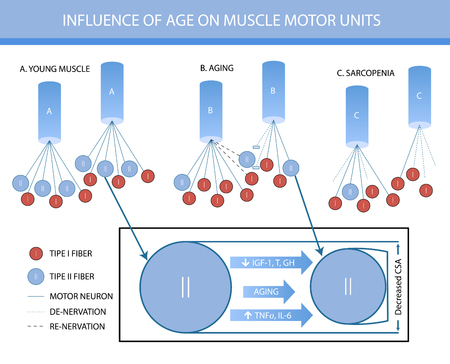Sarcopenia is the medical term describing the loss of muscle mass and strength with age. The muscle mass lost is primarily from fast-twitch muscle fibers. Sarcopenia is becoming recognized as a major cause of both disability and even morbidity among the elderly. However, as early as 30 years of age, sarcopenia can affect you. In simple terms, it is the loss of muscle mass as you age. It is not a disease though, although muscle wasting is accelerated by chronic diseases. Sarcopenia is thought to have multiple causes, though the relative importance of each is not clear. These include neurological, metabolic (BMR slows with aging), hormonal, nutritional, and physical-activity-related changes with age are all likely to contribute to the loss of muscle mass.
Sarcopenia strongly influences muscle strength and mobility and is a factor in the occurrence of frailty and likelihood of falls and fractures in the elderly and loss of energy and strength in the middle aged. Research with animals (in-vitro), experimental systems, on healthy humans and in those with diseases known to accelerate muscle mass loss, has shown repeatedly the safety and effectiveness of progressive resistance (strength) training in reversing sarcopenia and frailty in both the elderly and increasing vigor among the middle aged. Though we say elderly here, sarcopenia constantly progresses with age. In simple terms, again, about age 30, your body will lose about 1/3 to 1 pound of muscle mass per year. The unfortunate circumstance is that you tend to maintain the same diet and eating habits and thus, your weight remains the same. Therefore, instead of being composed of more lean muscle mass, your body actually adds more adipose tissue (fat cells) and at the same time, has less lean muscle. This is not beneficial for long-term health. The more you know about sarcopenia and its effects with age, the better you are able to combat it, which is actually as simple as having a persistent strength-training program combined with a cardiovascular program.
New methods are being developed to reverse and prevent the loss of muscle mass due to sarcopenia and new research may shed additional light on the mechanisms causing sarcopenia, including age-related alterations in hormones and in the immune system, and on the potential of exercise and diet to improve or prevent this situation. Until then, stick to the basics of exercise as the best method to combat it.
As a summary, currently we know several major factors concerning sarcopenia:
- Normal age-related changes in muscle mass loss include a loss of primarily fast-twitch muscle fibers, decreased protein synthesis and a deinnervation of motor units.
- Severe sarcopenia can lead to disability and can impair daily functioning.
- Both men and women are at risk of sarcopenia as testosterone and estrogen (hormones that help maintain muscle mass) decrease with age.
- Sedentary individuals and those suffering from debilitating or chronic diseases are at greatest risks of sarcopenia.
- Exercise via resistance training and cardiovascular training will dramatically reduce muscle loss with age due to sarcopenia.
There are many proposed treatments for sarcopenia, such as hormone replacement and diet modification. However, the only known treatment to reverse sarcopenia is EXERCISE, specifically resistance training. And, the best type of exercise training are those that work the fast-twitch muscle fibers such as sprinting, speed-strength full-body lifts, and stop and go anaerobic exercises. We have some of the best specialist in the world at My Health and Fitness that excel in both teaching the right exercises and creating individual programs to combat sarcopenia.
If you feel that sarcopenia is an issue due to age or training, please contact us at My Health and Fitness. We’ll help you on the right path. If you are over 50, please see our Seniors Fitness category for additional information.






